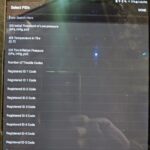An OBD2 reader can be a valuable tool for understanding your car’s health, but can you rely on it for accurate oil pressure readings? The answer is more nuanced than a simple yes or no. While an OBD2 scanner can detect issues related to oil pressure, it doesn’t directly measure it in most vehicles. This article explores why and discusses the limitations of using OBD2 for oil pressure monitoring.
OBD2 and Oil Pressure: Indirect Monitoring
OBD2 scanners primarily monitor emissions-related systems and don’t typically have direct access to the oil pressure sensor. Instead, they rely on indirect data to infer potential problems. For example, the OBD2 system might detect:
- P0520 Code: This diagnostic trouble code (DTC) indicates a problem with the engine oil pressure sensor/switch circuit. This suggests a potential issue with the sensor itself, the wiring, or the related circuitry, not necessarily low oil pressure.
- P0521, P0522, P0523, P0524 Codes: These codes indicate various levels of engine oil pressure sensor/switch performance issues, from low voltage to high voltage. Again, these point to sensor problems rather than direct pressure readings.
Why No Direct Oil Pressure Reading?
Most vehicles aren’t equipped with an oil pressure sensor connected to the OBD2 system. Manufacturers prioritize emissions monitoring for OBD2 compliance. Including a direct oil pressure reading through the OBD2 system would require additional hardware and increase manufacturing costs.
When an OBD2 Reader Can Help
While an OBD2 scanner won’t give you a precise oil pressure reading, it can still alert you to potential problems:
- Sensor Malfunction: As mentioned earlier, DTCs like P0520 can indicate a faulty oil pressure sensor, a crucial component for accurate oil pressure warnings. Addressing this issue is vital for reliable engine health.
- Indirect Clues: Although not a direct measurement, observing other parameters through your OBD2 scanner, like engine temperature and performance, can offer indirect clues about potential oil pressure issues. For instance, overheating could be linked to low oil.
The Importance of a Dedicated Oil Pressure Gauge
For accurate and real-time oil pressure monitoring, a dedicated oil pressure gauge is essential. This gauge directly connects to the oil pressure sensor and provides a precise reading. This is particularly valuable in vehicles that experience intermittent oil pressure fluctuations or for those who want a more comprehensive understanding of their engine’s lubrication system.
Conclusion: Rely on a Gauge, Not Just OBD2
While an OBD2 scanner is a useful diagnostic tool, it shouldn’t be your sole source for assessing oil pressure. It can alert you to potential sensor problems, but it won’t provide a direct pressure reading in most vehicles. For accurate monitoring, a dedicated oil pressure gauge remains the gold standard. If your car displays a low oil pressure warning, stop immediately and investigate further. Don’t solely rely on an OBD2 scan.


